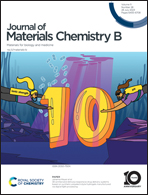Bioimaging of glutathione variation for early diagnosis of hepatocellular carcinoma using a liver-targeting ratiometric near-infrared fluorescent probe†
Abstract
Reliable biomarkers are crucial for early diagnosis of diseases and precise therapy. Biological thiols (represented by glutathione, GSH) play vital roles in the antioxidant defense system for maintaining intracellular redox homeostasis in organisms. However, the aberrant variation in the cellular concentration of GSH correlates with diverse diseases including cancer. Here, a ratiometric near-infrared fluorescent probe CyO-Disu is constructed for the specific sensing of GSH variation in live cells and mice models of hepatic carcinoma (HCC). CyO-Disu features three key elements, a response moiety of bis(2-hydroxyethyl) disulfide, a near-infrared fluorescence signal transducer of heptamethine ketone cyanine, and a targeting moiety of D-galactose. By virtue of its liver-targeting capability, CyO-Disu was utilized for evaluating GSH fluctuations in primary and metastatic hepatoma living cells. To evaluate the efficacy of CyO-Disuin vivo, orthotopic HCC and pulmonary metastatic hepatoma mice models were employed for GSH imaging using two-dimensional and three-dimensional fluorescence molecular tomographic imaging systems. The bioimaging results offered direct evidence that GSH displayed varied concentrations during the progression of HCC. Therefore, the as-synthesized probe CyO-Disu could serve as a potential powerful tool for the early diagnosis and precise treatment of HCC using GSH as a reliable biomarker.



 Please wait while we load your content...
Please wait while we load your content...